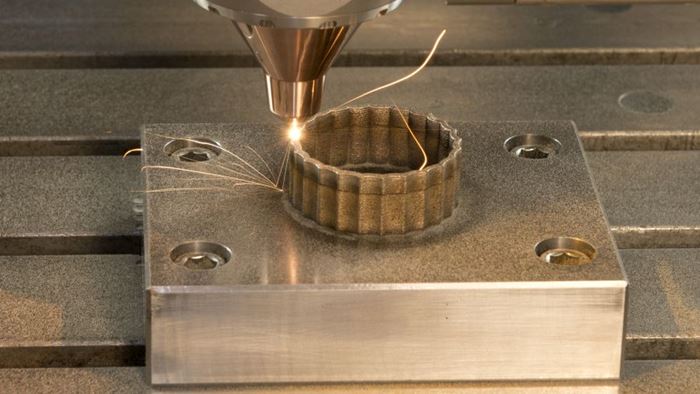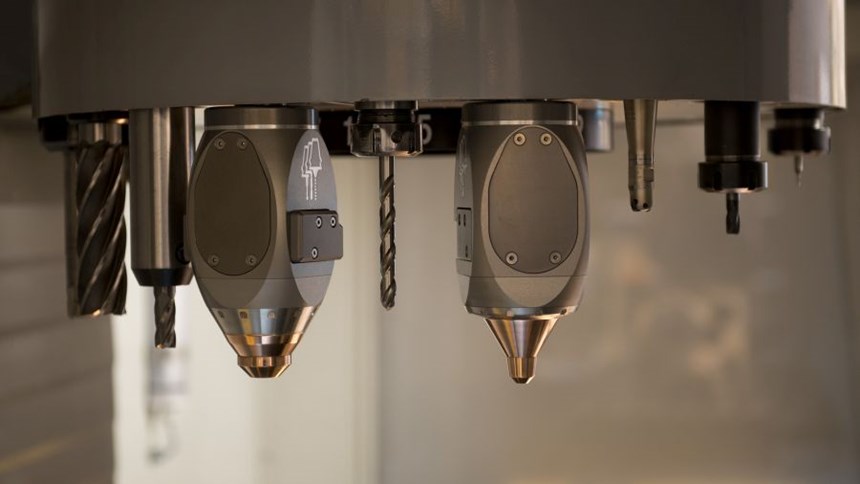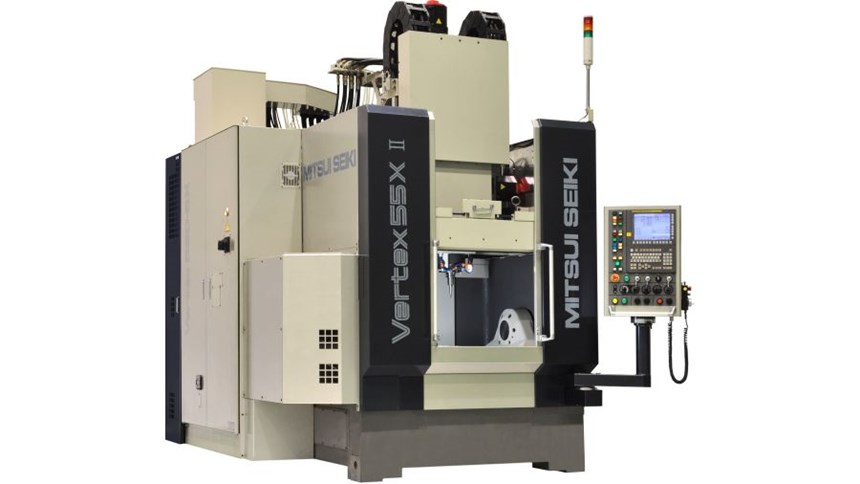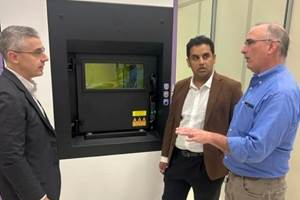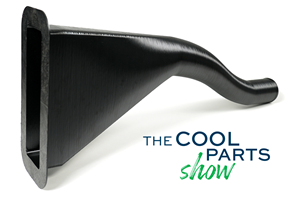Integrating Additive Without Inhibiting Machining
Can AM be added to a CNC machine tool while keeping the machine’s cutting capabilities fully intact?
Share
Read Next
Mitsui Seiki is a machine tool builder that aims to excel in the area of precision. It provides machines, often custom-engineered, to meet CNC machining challenges related to high-value parts with particularly demanding tolerances. The company’s introduction of additive manufacturing as a capability it can now deliver might therefore seem like an odd fit, since additive by itself can’t achieve anything like the fine tolerances that machining can.
But Robb Hudson, technology and business development manager for the company, says additive manufacturing is an addition to machining that brings both design freedom and process efficiency to complement machining’s precision. And by consolidating more of a part’s processing into a single machine, it potentially reduces part handling, which facilitates precision as well. During the past year or more that the company has been preparing to come to market with additive capability, he says, it has been experimenting with how to use metal cutting and metal deposition effectively within the same machine tool, without having to compromise the effectiveness or promise of either capability.
Mr. Hudson says essentially any of the company’s machines can now be made available as a hybrid system, capable of both additive and subtractive operations. A hybrid model of the company’s Vertex five-axis machining center will now be a standard product. The additive capability comes from the company’s partnership with Hybrid Manufacturing Technologies, the firm offering a system for integrating additive manufacturing capability into an existing machine tool. The Hybrid head performs metal additive manufacturing through laser cladding, feeding metal powder into a pool that is melted by a laser. The head mounts in the machine’s spindle using a toolholder, and when it is not in use, it waits in the machine’s carousel alongside other tools.
Yet integrating additive capability into the machine is not as simple as adding this head. The machine itself is also modified for safe use of the laser, as well as to enable powder flow. And if the full machining capabilities are to remain available, then new processing techniques along with other machine modifications are in order, too.
For example, what about coolant? Generally, coolant and lasers don’t mix, Mr. Hudson observes. But as part of the testing of additive/subtractive processing at Mitsui Seiki’s headquarters in Japan, the company has refined a process for using flood coolant extensively within a cycle that also includes additive layering. In this process, an air blow-off operation removes much of the volume of coolant still clinging to the part, followed by the laser applied at a wide focus to evaporate the rest. The surface dried in this way is ready for a new feature to be grown onto it through laser cladding.
A similarly important consideration is protection of the machine. Because some metal powder invariably escapes, preserving the machining precision demands ensuring that the powder does not affect sensitive mechanical systems such as the ballscrews and ways. Here, the company was able to draw on extensive prior experience, Mr. Hudson says. Guarding and other kinematic protections the company has engineered for machining centers used in precision graphite milling have been adapted to protecting the machine against metal powder.
The reward for all of this development will be the opportunity to deliver much more manufacturing capability within a single cycle, and bring much more of a part’s production into a single machine. CNC machining is the solution for tight precision, while additive manufacturing is potentially the solution where a high level of geometric complexity is needed. Those two benefits need not be separate—a part that includes geometrically challenging features is now also a part that can be machined to tight tolerances, without any handling or travel needed to transition between those objectives.
Indeed, that promise is particularly beneficial to manufacturers in the aerospace industry, Mr. Hudson says. A large portion of the machine tool builder’s customers are in this sector. “Their aim is often the buy-to-fly ratio, or how much material they have to purchase versus how much is left once all of the part’s machining is done,” he says. Buy-to-fly ratios are often high to machine elaborate aircraft components out of solid billet or even out of forgings, meaning material waste is high. But hybrid manufacturing offers a solution here as well. That is, instead of an oversize workpiece going into the machine to get much of its material cut away, what if a workpiece that was actually incomplete went into the machine instead? For material efficiency, some of this part’s features would still be produced through machining, while other features—narrow fins and other projections, for example—could instead be produced cost-effectively by additively building them on.
Related Content
At General Atomics, Do Unmanned Aerial Systems Reveal the Future of Aircraft Manufacturing?
The maker of the Predator and SkyGuardian remote aircraft can implement additive manufacturing more rapidly and widely than the makers of other types of planes. The role of 3D printing in current and future UAS components hints at how far AM can go to save cost and time in aircraft production and design.
Read MoreNew Zeda Additive Manufacturing Factory in Ohio Will Serve Medical, Military and Aerospace Production
Site providing laser powder bed fusion as well as machining and other postprocessing will open in late 2023, and will employ over 100. Chief technology officer Greg Morris sees economic and personnel advantages of serving different markets from a single AM facility.
Read MoreVideo: For 3D Printed Aircraft Structure, Machining Aids Fatigue Strength
Machining is a valuable complement to directed energy deposition, says Big Metal Additive. Topology-optimized aircraft parts illustrate the improvement in part performance from machining as the part is being built.
Read MoreAircraft Ducts 3D Printed in Composite Instead of Metal: The Cool Parts Show #68
Eaton’s new reinforced PEKK, tailored to aircraft applications, provides a cheaper and faster way to make ducts compared to formed aluminum.
Read MoreRead Next
Bike Manufacturer Uses Additive Manufacturing to Create Lighter, More Complex, Customized Parts
Titanium bike frame manufacturer Hanglun Technology mixes precision casting with 3D printing to create bikes that offer increased speed and reduced turbulence during long-distance rides, offering a smoother, faster and more efficient cycling experience.
Read MoreCrushable Lattices: The Lightweight Structures That Will Protect an Interplanetary Payload
NASA uses laser powder bed fusion plus chemical etching to create the lattice forms engineered to keep Mars rocks safe during a crash landing on Earth.
Read MoreProfilometry-Based Indentation Plastometry (PIP) as an Alternative to Standard Tensile Testing
UK-based Plastometrex offers a benchtop testing device utilizing PIP to quickly and easily analyze the yield strength, tensile strength and uniform elongation of samples and even printed parts. The solution is particularly useful for additive manufacturing.
Read More

